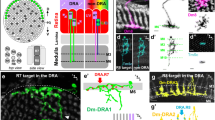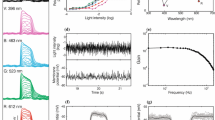Summary
-
1.
The transfer ofangular sensitivity from photoreceptors (retinula cells) to second order neurons (large monopolar cells — LMC's) is investigated by means of intracellular recordings from the retina and lamina ofHemicordulia tau. Angular sensitivity is measured by using a single point light source in two different ways. In the first, the constant intensity test flash method, responses to test flashes delivered at different angles of incidence are compared with the axial intensity/response function of the unit (Pig. 1). In the second, the off-axis intensity/ response function method, complete LMC intensity/response functions are derived at a number of angular inclinations toaxis (defined as the point of maximum sensitivity within the unit's visual field) (Fig. 4, 5).
-
2.
The constant intensity test flash method shows that dragonfly retinula cells have a high angular sensitivity when compared to other insects. The horizontal and vertical acceptance angles are 1.46°±0.44 and 1.31°±0.23 respectively. Application of this same method to LMC's demonstrates that they retain retinal acuity for their angular sensitivity functionsappear to be the same as those of retinula cells (Pig. 2, Table 1).
-
3.
The off-axis intensity/response functions show that the shape of the triphasic LMC response waveform depends upon the angular inclination of the stimulus to axis. The relative amplitudes of “on” transient and plateau (Pig. 3) vary independantly with angle (Pig. 4). The slope of the plateau response/log intensity curve decreases as the stimulus moves off axis but the “on” transient curve's slope remains relatively constant (Pig. 5).
-
4.
Constant intensity test flash methods cannot measure LMC angular sensitivity because the slope of the response/log intensity curves depend upon stimulus inclination. The off-axis intensity/response function method shows that lateral inhibition narrows the LMC visual fields (Fig. 6) and angular sensitivity is increased during the transfer of visual information (Pig. 7).
-
5.
Examination of the LMC response waveform (Fig. 8) and the intensity/response characteristics (Fig. 5) shows that two types of inhibition shape the response to square wave stimuli. Intracartridge inhibition acts at the level of the first synapses to attenuate the response to maintained stimuli. Intercartridge inhibition acts with a time delay to depolarise the LMC membrane and increase angular sensitivity.
-
6.
It is concluded that LMC's integrate retinal input by acting as high sensitivity detectors of contrast differences within the spatial domain. Their role as an input to the visual system is discussed in relationship to visual behaviour and its experimental analysis.
Similar content being viewed by others
References
Arnett, D. W.: Spatial and temporal integration properties of units in the first optic ganglion of Dipterans. J. Neurophysiol.35, 429–444 (1972)
Autrum, H., Zettler, F., Järvilehto, M.: Postsynaptic potentials from a single monopolar neuron of the ganglion opticum I of the blowflyCalliphora. Z. vergl. Physiol.70, 414–424 (1970)
Boschek, C. B.: On the fine structure of the peripheral retina and lamina ganglionaris of the fly,Musca domestica. Z. Zellforsch.118, 369–409 (1971)
Braitenberg, V. B.: Patterns of projection in the visual system of the fly. I. Retina- lamina projections. Exp. Brain Res.3, 271–298 (1967)
Chappell, R. L., Dowling, J. E.: Neural organisation of the median ocellus of the dragonfly. I. Intracellular electrical activity. J. gen. Physiol.60, 121–147 (1972)
Doving, K. B., Miller, W. H.: Function of insect compound eyes containing crystalline tracts. J. gen. Physiol.54, 250–267 (1969)
Dowling, J. E., Chappell, R. L.: Neural organisation of the median ocellus of the dragonfly. II. Synaptic structure. J. gen. Physiol.60, 148–165 (1972)
Eheim, W. P., Wehner, R.: Die Sehfelder der zentralen Ommatidien in den Appositionsaugen vonApis mellifica undCataglyphis bicolor (Apidae, Pormioidae; Hymenoptera). Kybernetik10, 168–179 (1972)
Hartline, H. K.: Visual receptors and retinal interaction. Science164, 270–278 (1969)
Hartline, H. K., Ratliff, F.: Inhibitory interaction in the retina ofLimulus. In: Handbook of sensory physiology, vol. VII/2, pp. 381–447. (M. G. F. Puortes, ed.). Berlin-Heidelberg-New York: Springer 1972
Horridge, G. A.: Unit studies on the retina of dragonflies. Z. vergl. Physiol.62, 1–37 (1969)
Horridge, G. A., Meinertzhagen, I. A.: The exact neural projection of the visual fields upon the first and second ganglia of the insect eye. Z. vergl. Physiol.66, 369–378 (1970)
Järvilehto, M., Zettler, F.: Localised intracellular potentials from pre- and post- synaptic components in the external plexiform layer of an insect retina. Z. vergl. Physiol.75, 422–440 (1971)
Järvilehto, M., Zettler, J.: Electrophysiological-histological studies on some functional properties of visual cells and second order neurons of an insect retina. Z. Zellforseh.136, 291–306 (1973)
Kirschfeld, K.: Die Projektion der optischen Umwelt auf das Raster der Rhabdomere im Komplexauge vonMusca. Exp. Brain Res.3, 248–270 (1967)
Laughlin, S. A.: Neural integration in the first optic neuropile of dragonflies. I. Signal amplification in dark-adapted second order neurons. J. comp. Physiol.84, 335–355 (1973)
Laughlin, S. B.: Neural integration in the first optic neuropile of dragonflies. II. Receptor signal interactions in the lamina. J. comp. Physiol.92, 357–375 (1974)
Laughlin, S. B., Horridge, G. A.: Angular sensitivity of the retinula cells of dark- adapted worker bee. Z. vergl. Physiol.74, 329–335 (1971)
Meyer, H.W.: Ethometrical investigations into spatial interaction within the visual system ofVelia caprai (Hemiptera, Heteroptera). In: Information processing in the visual systems of arthropods (R. Wehner, ed.), pp. 223–229. Berlin-Heidelberg-New York: Springer 1972
Pritchard, G.: On the morphology of the compound eyes of dragonflies (Odonata: Anisoptera), with special reference to their role in prey capture. Proc. roy. ent. Soc. Lond. (A)41, 1–8 (1966)
Ratliff, F.: Mach bands: quantitative studies on neural networks in the retina. San Francisco-London-Amsterdam: Holden-Day 1965
Scholes, J.: The electrical responses of the retinal receptors and the lamina in the visual system of the flyMusca. Kybernetik6, 149–162 (1969)
Shaw, S. R.: Organization of the locust retina. Symp. zool. Soc. Lond.23, 135–163 (1968)
Snyder, A. W., Menzel, R., Laughlin, S. B.: The structure and function of the fused rhabdom. J. comp. Physiol.87, 99–135 (1973)
Strausfeld, N. J.: The organization of the insect visual system (light microscopy). II. Projection of fibres across the first optic chiasma. Z. Zellforseh.121, 442–454 (1971b)
Strausfeld, N. J., Campos-Ortega, J.A.: Some interrelationships between the first and second synaptic regions of the fly's (Musca, domestica L.) visual system. In: Information processing in the visual systems of arthropods. (R. Wehner, ed.), pp. 23–30. Berlin-Heidelberg-New York: Springer 1972
Trujillo-Cenóz, O.: Some aspects of the structural organisation of the intermediate retina of Dipterans. J. Ultrastruct. Res.13, 1–33 (1965)
Trujillo-Cenóz, O., Melamed, J.: Compound eye of Dipterans: anatomical basis for integration—an electron microscope study. J. Ultrastruct. Res.16, 395–398 (1966)
Werblin, F. S.: Functional organization of a vertebrate retina: sharpening up in space and intensity. Ann. N. Y. Acad. Sci.193, 75–85 (1972)
Werblin, P. S., Dowling, J. E.: Organization of the retina of the mudpuppyNecturus maculosus. II. Intracellular recording. J. Neurophysiol.32, 339–335 (1969)
Wiedemann, I.: Versuche über den Strahlengang im Insektenauge (Appositionsauge). Z. vergl. Physiol.49, 526–542 (1965)
Zettler, F., Järvilehto, M.: Lateral inhibition in an insect eye. Z. vergl. Physiol.76, 233–244 (1972)
Author information
Authors and Affiliations
Additional information
During the preparation of this and the previous paper many people gave freely of their time and expertise. My supervisors Professors G. A. Horridge and Randolf Menzel guided and encouraged me, Margaret Blakers expertly processed much of the raw experimental data and Mike Bate and Mark Leggett made sense of the original manuscripts. Finally I would like to thank Professor Kuno Kirschfeld for his constructive suggestions on the presentation and interpretation of these results.
Rights and permissions
About this article
Cite this article
Laughlin, S.B. Neural integration in the first optic neuropile of dragonflies. J. Comp. Physiol. 92, 377–396 (1974). https://doi.org/10.1007/BF00694708
Received:
Issue Date:
DOI: https://doi.org/10.1007/BF00694708




